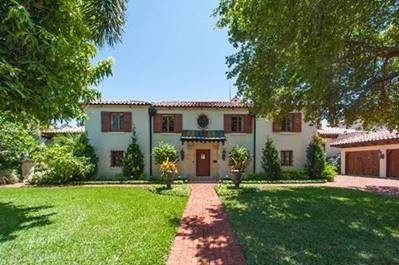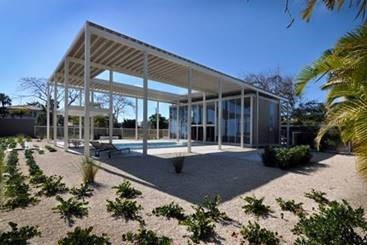
For Immediate Release
Tuesday, March 26, 2019
Contact: Sarah Revell
850.245.6522
[email protected]
Secretary Lee Announces the Designation of Three Florida Homes on the National Register of Historic Places
Tallahassee –
Secretary of State Laurel M. Lee announced today that the Siegmund and Marilyn Goldman House in Maitland and the Charles E. Leigh Home and the Umbrella House in Sarasota have been listed on the National Park Service’s National Register of Historic Places.
“The addition of these three historic Florida homes to the National Register of Historic Places reflects the evolution of the state’s architectural forms from the 1930s through the mid-century period,” said Secretary Lee. “The design of these homes demonstrates the various ways architects through the ages attempted to represent and enhance the lives of Floridians, embracing the tropical climate and aesthetics of the state.”
The Siegmund and Marilyn Goldman House, located in Orange County, is one of the most prominent and best-preserved residential designs of Nils M. Schweizer, a significant mid-20th century architect who trained under and worked for internationally-renowned architect Frank Lloyd Wright. Schweizer and his firm are credited with more than 100 designs in the state of Florida, primarily commercial and religious buildings, complemented by a smaller number of custom-designed residences.

The Siegmund and Marilyn Goldman House demonstrates characteristic features developed and used by Schweizer and is a locally significant example of Modern Movement Florida residential architecture. Defining features include an emphasis on horizontal planes, geometrically-defined spaces, an indoor-outdoor relationship between the building and the landscape and enormous windows - including “transparent” windows butting the glass together so that the corner of the structure appears translucent. Schweizer-designed modernist “dentil” details, so termed because the trim work has the appearance of gapped teeth, appear throughout the building on the cornice line, the concrete mantelpiece and in the cabinet hardware.
The Charles E. Leigh Home, located in Sarasota County, is a well-preserved example of Sarasota’s early-twentieth-century Mediterranean Revival architectural heritage. The house was built in 1937 as a winter home for Charles E. Leigh, a Minnesotan who was the inventor of Lavoris mouthwash.

The Charles E. Leigh Home’s design is characterized by its red barrel tile roof, stucco siding and heavy use of archways on the exterior façade and interior doorways. Distinctive architectural features include a spiral staircase in the entrance room and a loggia at the back of the house. A balcony has since been created in the entrance room and the loggia has been enclosed, but their character and appearance have been sufficiently preserved to express the original design intention of the property. Today, the Charles E. Leigh Home remains a private residence.
The Umbrella House, located in Sarasota County, gained its name because of the large wood-louvered structure covering the entire house for the purpose of imposing partial shade from Florida’s penetrating sun. The Umbrella House was designed by architect Paul Rudolph as a residence and studio for developer Philip Hiss. Its iconic design is representative of the Sarasota School of Architecture, southwest Florida’s post World War II modern design movement.

The Umbrella House is likely the most ambitious work undertaken by Paul Rudolph in the early 1950s, and embodies the distinctive characteristics of American modernist construction as applied to a Florida beach house. It is primarily on the basis of this commission and other Florida beach houses that Rudolph was awarded the Outstanding Young Architect Award at a 1954 international competition in Sao Paolo, Brazil. In 1956, Time Magazine listed Rudolph among “modern architects whose contribution has been significant,” describing him as a “fast rising, Harvard-trained comer whose reputation is based on his self-styled ‘structural-exhibitionist’ Florida houses.”
Rudolph went on to serve as chair of Yale University’s Department of Architecture and worked on commissions around the globe until his death in 1997. He is known today as one of the pioneers of the Sarasota School of Architecture. The “umbrella” of the home was lost in 1966 Hurricane Alma, but was reconstructed by the current homeowners in 2015 based on the original plans, making way for its listing on the National Register.
# # #
About the National Register of Historic Places
The National Register of Historic Places is a list maintained by the National Park Service which includes historical or archaeological properties including buildings, structures, sites, objects, and districts, that are considered worthy of preservation because of their local, statewide and/or national significance. Nominations for properties in Florida are submitted to the National Park Service through the Florida Department of State’s Division of Historical Resources. Florida has over 1,700 listings on the National Register, including 295 historic districts and 175 archaeological sites. There are more than 50,000 sites contributing to the National Register in Florida. For more information, visit flheritage.com/preservation/national-register. For more information about the National Register of Historic Places program administered by the National Park Service, visit nps.gov/nr.
About the Florida Department of State’s Bureau of Historic Preservation The Bureau of Historic Preservation (BHP) conducts historic preservation programs aimed at identifying, evaluating, preserving and interpreting the historic and cultural resources of the state. The Bureau manages the Florida Main Street Program, and under federal and state laws, oversees the National Register of Historic Places program for Florida, maintains an inventory of the state's historical resources in the Florida Master Site File, assists applicants in federal tax benefit and local government ad valorem tax relief programs for historic buildings, and reviews the impact that development projects may have on significant historic resources. For more information, visit flheritage.com/preservation.
